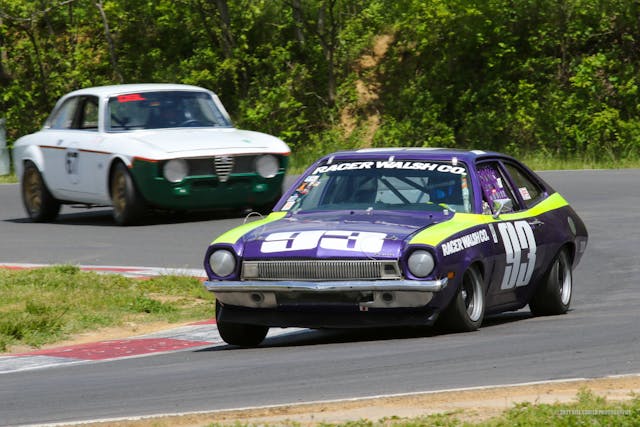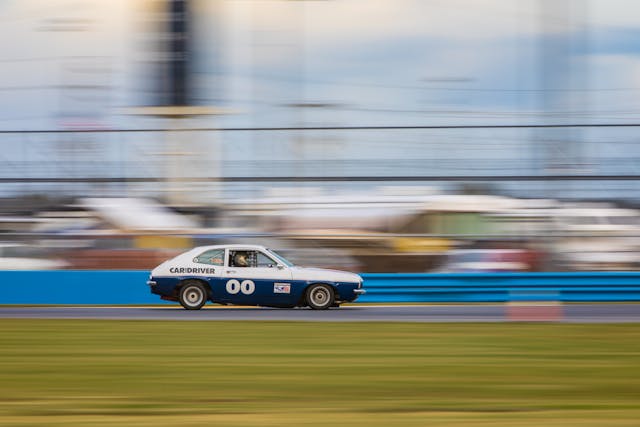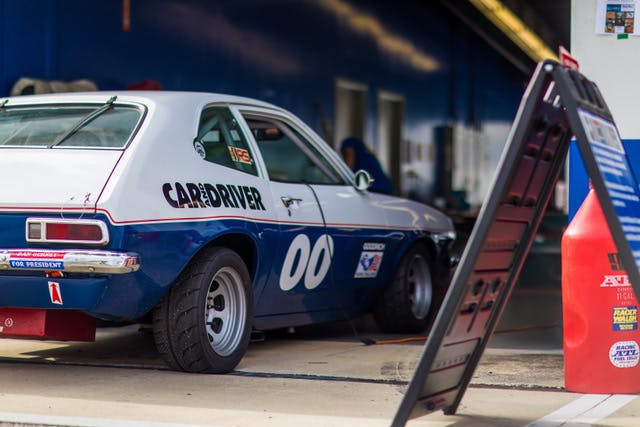This pair of prolific Pintos highlight the 39th Annual Lime Rock Park Historic Festival
“People won’t remember a white Pinto, but they sure as heck will remember a purple Pinto,” says Brian Walsh, explaining why he restored his father’s Ford back to its unique shade of lilac. The pint-sized purple sedan, originally built and campaigned by his late father Jerry, is one of two Pintos Brian owns. The other, a ’72 featuring double-zeros on the doors, was built in 1974 by automotive journalist, racer, and Hagerty contributor Patrick Bedard. Both compact sedans will compete in the Historic Festival at Lime Rock Park in Connecticut, September 3-6, marking 50 years since the International Motor Sport Association (IMSA) debuted its Baby Grand series.
In 1963, Jerry Walsh turned 21, meaning he was finally eligible to compete in SCCA. He received his license and began campaigning Sprites and Healeys before stuffing the latter into a ditch at Pocono Raceway, circa 1970. It was from then on he vowed to never again to race anything with a single-reservoir master cylinder.
By 1971, the elder Walsh had saved enough cash, selling electric signs in Manhattan for the Philadelphia Sign Company, to purchase a compact for his next high-speed foray. He would compete in IMSA’s new entry-level class Radial Sedan (aka Baby Grand) but needed to choose a car first. The undercard class featured a wide array of economy sedans, rapidly growing in popularity amid the Oil Crisis. Chevy Vegas, Dodge Colts, AMC Gremlins, and Pacers banged doors with BMWs, Opels, and Datsuns, and the parody provided excellent racing entertainment. “Some cars had more powerful engines, but handled poorly, and others had great handling but less horsepower,” says Brian, “so everyone had a chance to be competitive, depending on the particular track.”

“My dad decided he was either going to buy a Vega or a Pinto,” says Brian. “He chose correctly and bought a Pinto,” hinting at the 50-year-old Pinto part business Racer Walsh Co. that Brian still manages today. As more racers began to huck Pintos around tracks nationwide, Jerry decided to start his own business selling Pinto parts, and based the operation in Suffern, New York. As for his own Pinto, Jerry raced the car in 1971 and then prepped it for the upcoming ’72 season, painting it purple as an homage to his old Healey that was painted with leftover paint from North Jersey dessert company T & W Ice Cream. The purple Pinto, Jerry’s business, and IMSA’s new series all took off.

Entry lists featuring 50-60 RS cars were routine from 1973 to 1979. In 1974, Bedard built his own 1972 Pinto for the compact series. “That car is trick,” says Brian of the car Racer Walsh Co. featured in their parts catalog back in the day. Bedard grafted the front suspension from a 1974 Pinto, which featured bigger brakes and a more modern steering rack, onto his ’72. He also affixed a stock-car-style sway bar up front. Painted white and blue, the #00 Pinto was sponsored by Bedard’s employer, Car and Driver. Fellow buff mag editor (and fellow Hagerty contributor) Don Sherman was originally penciled in as co-driver, but obligation took him elsewhere, so constructor Ron Nash joined Bedard in the Pinto’s seat. The duo earned two poles and a victory at Charlotte.
The Pinto went missing after some decades, until Sherman was reunited with the old race car in 2005. He restored the compact to its pole position prominence. The car traded coasts and hands before it was eventually purchased by Brian Walsh and trucked back from Riverside, California to Racer Walsh Co. in Jacksonville, Florida.
Brian’s return to Lime Rock in his 200-horsepower curb-hopping purple Pinto is a homecoming of sorts, one that’s 26 years in the making. “Lime Rock was our home track,” says Brian. Thinking back to his teens, the 54-year-old racer can still picture the big-block Corvettes and Camaros thundering around the 1.5-mile course.
In 1988, Brian and Jerry finally had the chance to compete at their home track together, as they co-drove an ’87 notchback Mustang in a three-hour endurance race. Despite the connection to the track, Brian turned his final laps at Lime Rock in 1994, in his father’s Pinto, and hasn’t returned since. The stopwatch kept ticking, though. Brian continued to race, around the Daytona highbanks, over the Sebring bumps, but his father retired from his 43-year semi-professional racing career in 2005. The return to Lime Rock—the first trip over the Bailey Bridge, the first time Brian shoots down the Sam Posey straight—will surely conjure memories and emotions from bygone race days. Beyond the evocations, Brian’s return will be supremely special for another reason: This time, Brian will bring his father back to their home track, in a Moroso billet aluminum air-oil separator doubling as an urn.

Four years ago, Brian’s father passed after a several-year-bout with ALS, but not before suggesting to his son that he carry his ashes in the beloved Pinto. Brian replied: “Alright, I’ll do it for a race.”
“Why a race?” Jerry fired back. “Why not do it permanently?”
So now, Brian carries around his father’s ashes from course to course strapped to the chrome moly roll cage. A couple years ago, resident Barn Find Hunter and racer Tom Cotter spotted Jerry’s urn at a vintage car gathering. Cotter suggested to Brian that he spread Jerry’s ashes at every track that his father raced back in the day. “I thought it was good idea,” says Brian. Since then, from Daytona to Thompson, Sebring to New Jersey Motorsports Park, Brian fills his father’s old pool water sampling bottle with his ashes and pours them out the window while he’s racing.
Both of Brian’s Pintos will carry some of Jerry’s ashes at Lime Rock’s historic meet. Brian will be a the wheel of his father’s car, and none other than Tom Cotter will pilot the C/D sedan. If you visit Lime Rock for this year’s Historic gathering on Labor Day weekend, you likely wont forget the the purple Pinto, nor its blue and white compatriot.






Excellent!!!
Your Dad will be looking down in admiration.